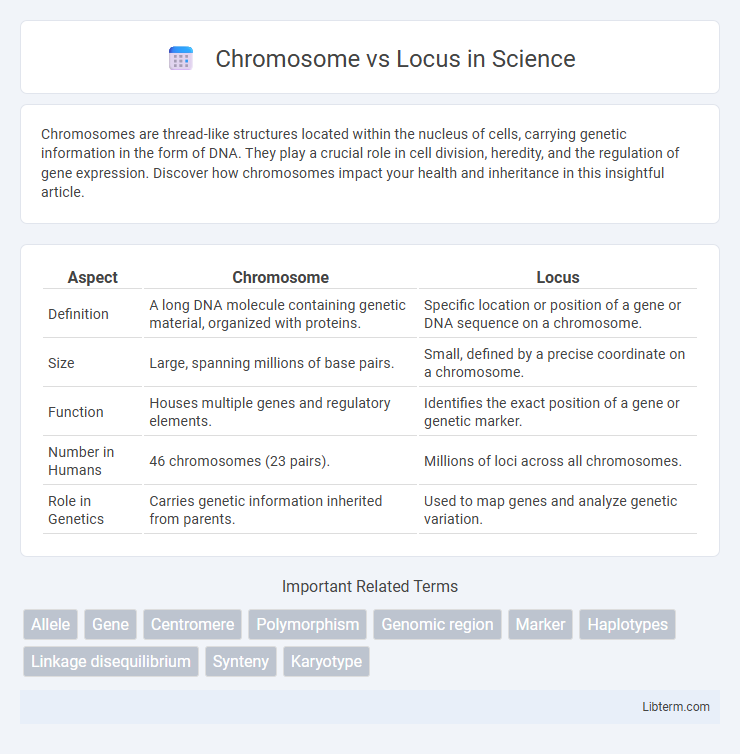Chromosomes are thread-like structures located within the nucleus of cells, carrying genetic information in the form of DNA. They play a crucial role in cell division, heredity, and the regulation of gene expression. Discover how chromosomes impact your health and inheritance in this insightful article.
Table of Comparison
| Aspect | Chromosome | Locus |
|---|---|---|
| Definition | A long DNA molecule containing genetic material, organized with proteins. | Specific location or position of a gene or DNA sequence on a chromosome. |
| Size | Large, spanning millions of base pairs. | Small, defined by a precise coordinate on a chromosome. |
| Function | Houses multiple genes and regulatory elements. | Identifies the exact position of a gene or genetic marker. |
| Number in Humans | 46 chromosomes (23 pairs). | Millions of loci across all chromosomes. |
| Role in Genetics | Carries genetic information inherited from parents. | Used to map genes and analyze genetic variation. |
Introduction to Chromosomes and Loci
Chromosomes are long DNA molecules that contain genetic material organized into genes, essential for heredity and cellular function. A locus refers to a specific, fixed position on a chromosome where a particular gene or genetic marker is located. Understanding the relationship between chromosomes and loci is fundamental in genetics for identifying gene locations and studying hereditary traits.
Defining Chromosome: Structure and Function
Chromosomes are long, thread-like structures composed of DNA and proteins, housed within the nucleus of eukaryotic cells, responsible for storing and transmitting genetic information. Each chromosome contains numerous genes and loci, which are specific fixed positions where genes or genetic markers reside. The primary function of chromosomes is to ensure accurate DNA replication and distribution during cell division, maintaining genetic continuity across generations.
What Is a Genetic Locus?
A genetic locus refers to a specific, fixed position on a chromosome where a particular gene or genetic marker is located. Each chromosome contains numerous loci, which serve as addresses for genes that determine hereditary traits. Understanding loci enables precise identification of gene locations for genetic mapping and analysis.
Chromosome vs Locus: Key Differences
Chromosomes are large, organized structures of DNA and protein found in cells that carry genetic information, whereas loci (singular: locus) refer to specific, fixed positions on a chromosome where particular genes or genetic markers are located. Chromosomes contain many loci, each representing different genes or regulatory elements essential for heredity and biological functions. The key difference lies in scale: chromosomes are whole DNA molecules, while loci denote precise locations within these molecules.
Role of Chromosomes in Heredity
Chromosomes are thread-like structures composed of DNA and proteins that carry genetic information essential for heredity, ensuring traits are passed from parents to offspring. Each chromosome contains numerous loci, specific locations where individual genes reside, influencing various inherited characteristics. The accurate replication and segregation of chromosomes during cell division enable the stable transmission of genetic material across generations.
Role of Loci in Genetic Variation
Loci are specific positions on a chromosome that serve as sites for genes or genetic markers, playing a crucial role in genetic variation by harboring alleles that differ among individuals. These variations at loci contribute to phenotypic diversity, influencing traits and susceptibility to diseases within populations. Understanding the arrangement and variation of loci on chromosomes is essential for studying heredity, population genetics, and evolutionary biology.
Chromosomal Disorders vs Locus Mutations
Chromosomal disorders arise from large-scale abnormalities such as deletions, duplications, or rearrangements affecting entire chromosomes or significant segments, often leading to conditions like Down syndrome or Turner syndrome. Locus mutations refer to specific alterations in the DNA sequence at a particular location on a chromosome, such as point mutations or small insertions/deletions, typically causing single-gene disorders like cystic fibrosis or sickle cell anemia. Understanding the distinction between chromosomal abnormalities and locus-specific mutations is crucial for accurate diagnosis and targeted genetic therapies.
Methods for Identifying Chromosomes and Loci
Methods for identifying chromosomes involve karyotyping, where chromosomes are visualized under a microscope during metaphase to observe their size, shape, and banding patterns using techniques such as G-banding. Fluorescence in situ hybridization (FISH) enables the detection of specific loci by using fluorescent probes that bind to targeted DNA sequences on chromosomes, allowing precise localization of genes or genetic markers. Advanced methods like comparative genomic hybridization (CGH) and next-generation sequencing (NGS) provide high-resolution identification of chromosomal abnormalities and detailed analysis of loci variations.
Chromosome Mapping and Locus Identification
Chromosomes are long DNA molecules carrying numerous genes arranged in specific sequences, serving as the primary structures for chromosome mapping. Locus identification pinpoints exact positions of genes within a chromosome, crucial for understanding gene function and hereditary patterns. Precise chromosome mapping combined with locus identification enables targeted genetic research and advances in medical genetics, such as disease gene localization.
Conclusion: Understanding Genetic Architecture
Chromosomes serve as the large physical structures that organize and carry genetic material within a cell, while loci represent specific, fixed positions on these chromosomes where genes or genetic markers reside. Grasping the relationship between chromosomes and loci is essential for unraveling the complexity of genetic architecture, as it enables precise identification of gene functions and inheritance patterns. This understanding is fundamental for advances in genetics, genomics, and personalized medicine.
Chromosome Infographic

 libterm.com
libterm.com